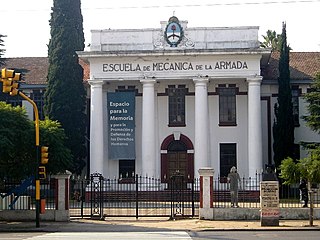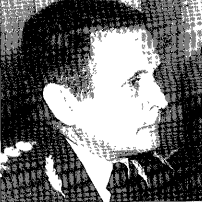Related Research Articles

Operation Condor was a United States-backed campaign of political repression and state terrorism, involving intelligence operations, CIA-backed coups, as well as assassinations of left-wing and socialist leaders in South America from 1968 to 1989. Operation Condor was officially and formally implemented in November 1975 by the right-wing dictatorships of the Southern Cone of South America.

Jorge Rafael Videla was an Argentine military officer and dictator, Commander in Chief of the Army, member of the Military Junta, and de facto President of Argentina from 29 March 1976 to 29 March 1981. His reign, which was during the time of Operation Condor, was among the most infamous in Latin America during the Cold War due to its high level of human rights abuses and severe economic mismanagement.

The Dirty War is the name used by the military junta or civic-military dictatorship of Argentina for the period of state terrorism in Argentina from 1974 to 1983 as a part of Operation Condor, during which military and security forces and death squads in the form of the Argentine Anticommunist Alliance hunted down any political dissidents and anyone believed to be associated with socialism, left-wing Peronism, or the Montoneros movement.

The Mothers of the Plaza de Mayo is an Argentine human rights association formed in response to the National Reorganization Process, the military dictatorship by Jorge Rafael Videla, with the goal of finding the desaparecidos, initially, and then determining the culprits of crimes against humanity to promote their trial and sentencing.

The Grandmothers of the Plaza de Mayo is a human rights organization with the goal of finding the children stolen and illegally adopted during the 1976–1983 Argentine military dictatorship. The president is Estela Barnes de Carlotto.
Alfredo Ignacio Astiz is an Argentine former military commander, intelligence officer, and naval commando who served in the Argentine Navy during the military dictatorship of Jorge Rafael Videla during the Proceso de Reorganización Nacional (1976–1983). He was known as El Ángel Rubio de la Muerte, and had a reputation as a torturer. He was discharged from the military in 1998 after defending his actions in a press interview.

The Higher School of Mechanics of the Navy has gone through three major transformations throughout its history. Originally ESMA served as an educational facility of the Argentine Navy. The original ESMA was a complex located at 8151 Libertador Avenue, in the Autonomous City of Buenos Aires, in the barrio of Núñez. Additionally, It was the seat of U.T.3.3.2—Unidad de Tareas 2 of G.T.3.3 [es].

The National Reorganization Process was the military dictatorship that ruled Argentina from 1976 to 1983, which received support from the United States until 1982. In Argentina it is often known simply as the última junta militar, última dictadura militar or última dictadura cívico-militar, because there have been several in the country's history and no others since it ended.

Léonie Duquet was a French nun who was arrested in December 1977 in Buenos Aires, Argentina, and "disappeared". She was believed killed by the military regime of Argentine President Jorge Rafael Videla during the Dirty War. Alice Domon, a French nun working with Duquet, disappeared a few days later. They had been working in poor neighborhoods of Buenos Aires in the 1970s and supported the Mothers of the Plaza de Mayo, founded in 1977. Despite repeated efforts by France to trace the sisters, the Argentine military dictatorship was unresponsive. In 1990 a French court in Paris tried Argentine Captain Alfredo Astiz, known to have arrested Duquet and believed implicated in the "disappearance" of Domon, for kidnapping the two sisters. He was convicted and sentenced to life imprisonment in absentia. In Argentina at the time, he and other military and security officers were shielded from prosecution by Pardon Laws passed in 1986 and 1987. These were repealed in 2003 and ruled unconstitutional in 2005, and the government re-opened prosecution of war crimes.

Emilio Eduardo Massera was an Argentine Naval military officer, and a leading participant in the Argentine coup d'état of 1976. In 1981, he was found to be a member of P2, a clandestine Masonic lodge involved in Italy's strategy of tension. Many considered Massera to have masterminded the junta's Dirty War against political opponents, which resulted in over 30,000 deaths and disappeances.
National Commission on the Disappearance of Persons was an Argentine organization created by President Raúl Alfonsín on 15 December 1983, shortly after his inauguration, to investigate the fate of the desaparecidos and other human rights violations performed during the military dictatorship known as the National Reorganization Process between 1976 and 1983.

Rodolfo Jorge Walsh was an Argentine writer and journalist of Irish descent, considered the founder of investigative journalism in Argentina. He is most famous for his Open Letter from a Writer to the Military Junta, which he published the day before his murder, protesting that Argentina's last civil-military dictatorship's economic policies were having an even greater and disastrous effect on ordinary Argentines than its widespread human rights abuses.

The Trial of the Juntas was the judicial trial of the members of the de facto military government that ruled Argentina during the dictatorship of the Proceso de Reorganización Nacional, which lasted from 1976 to 1983. It is so far the only example of such a large scale procedure by a democratic government against a former dictatorial government of the same country in Latin America.

Miguel Osvaldo Etchecolatz was an Argentine police officer, who worked in the Buenos Aires Provincial Police during the first years of the military dictatorship of the 1970s. Etchecolatz was deeply involved in the "anti-subversion operation" known as the National Reorganization Process. He was first convicted in 1986 of crimes committed during this period, but passage that year of the Ley de Punto Final, which created amnesty for security officers, meant that he was released without a sentence. In 2003 Congress repealed the law, and the government re-opened prosecution of crimes during the Dirty War.

Luis María Mendía was the Argentine Chief of Naval Operations in 1976-77, with the rank of vice-admiral. According to confessions gathered by Horacio Verbitsky and made by Adolfo Scilingo, Luis María Mendía was the architect of the "death flight" assassination method whereby the Argentine state disappeared people by throwing them out of aircraft over the ocean, thus making the retrieval of their corpses nearly impossible. This method was set out in the Plancitara military plan of 1975, during Isabel Perón's government.

Alicia Domon was a French nun who was one of two French nationals in Argentina to be "disappeared" in December 1977 by the military dictatorship of the National Reorganization Process. She was among a dozen people associated with the Mothers of the Plaza de Mayo, a human rights group, who were kidnapped and taken to the secret detention center at ESMA.

The San Patricio Church massacre was the mass murder of three priests and two seminarians of the Pallottine order on July 4, 1976, during the Dirty War, at St. Patrick's Church, located in the Belgrano neighborhood of the Buenos Aires, Argentina. The victims were priests Alfredo Leaden, Alfredo Kelly, and Pedro Duffau and seminarians Salvador Barbeito and Emilio Barletti. The murders were ordered by Argentine Navy Rear Admiral Ruben Chamorro.

María Eugenia Ponce de Bianco was an Argentine social activist. She was one of the founders of the Mothers of the Plaza de Mayo, an organization which searched for desaparecidos. She was kidnapped, tortured, and murdered as a result of her involvement with the group.

Elena Angélica Dolores Holmberg Lanusse, better known as Elena Holmberg, was an Argentine diplomat who was kidnapped and assassinated in 1978. Distinguished for being the first woman to graduate from the Institute of Foreign Services of the Nation, Holmberg was an important official of the military dictatorship which took power in 1976, and is generally believed to have been detained-disappeared and then killed by the regime to which she belonged.
In Argentina, the term "impunity laws" refers to two laws and a series of presidential decrees enacted between 1986 and 1990, which prevented the prosecution or execution of convictions against perpetrators of crimes against humanity during the state terrorism carried out by the Military Junta in the 1976 civil-military coup d'état, which governed from 1976 to 1983. On May 3, 2017, the Supreme Court issued a ruling that allows the sentences of persons found guilty of crimes against humanity to be significantly reduced, by application of the so-called "two for one".
References
- ↑ Condenaron a prisión perpetua a Alfredo Astiz y a Jorge “El Tigre” Acosta por crímenes cometidos en la ESMA, Centro de Información Judicial, 26 October 2011
- ↑ Acosta, Desaparecidos
- ↑ Los rostros del terror van al banquillo, Página/12, 22 August 2006 (in Spanish)
- ↑ Por el asesinato de una italoargentina en 1976: Piden en Italia que se procese a Massera, Astiz y Acosta, Clarín , 17 November 2004 (in Spanish)
- ↑ Italia: Someterán a proceso a altos oficiales argentinos Archived 2007-09-27 at the Wayback Machine , El Reloj , 6 April 2006
- ↑ Quién es cada uno de los 18 juzgados, 26 October 2011 (in Spanish)
- ↑ Junta leaders found guilty of stealing babies, July 06, 2012, http://www.abc.net.au/news/2012-07-06/junta-leaders-found-guilty-of-stealing-babies-in-argentina/4114032